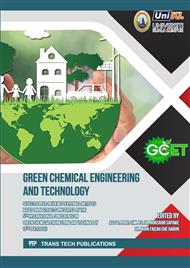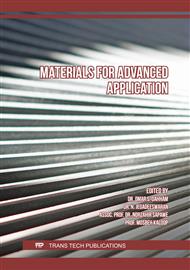[1]
A.G. Pereira, T.M. Lima, and F. Charrua-santos, Industry 4.0 and Society 5.0: Opportunities and Threats,, Int. J. Recent Technol. Eng., vol. 8, no. 5, p.3305–3308, (2020).
Google Scholar
[2]
A. Manthiram, A reflection on lithium-ion battery cathode chemistry,, Nat. Commun., vol. 11, no. 1, p.1–9, (2020).
DOI: 10.1038/s41467-020-15355-0
Google Scholar
[3]
M. Hartono, M.A. Astrayudha, H.T.B. M. Petrus, W. Budhijanto, and H. Sulistyo, Lithium recovery of spent lithium-ion battery using bioleaching from local sources microorganism,, Rasayan J. Chem., vol. 10, no. 3, p.897–903, (2017).
DOI: 10.7324/rjc.2017.1031767
Google Scholar
[4]
B.K. Biswal, U.U. Jadhav, M. Madhaiyan, L. Ji, E.H. Yang, and B. Cao, Biological Leaching and Chemical Precipitation Methods for Recovery of Co and Li from Spent Lithium-Ion Batteries,, ACS Sustain. Chem. Eng., vol. 6, no. 9, p.12343–12352, (2018).
DOI: 10.1021/acssuschemeng.8b02810
Google Scholar
[5]
R. Marcinčáková, J. Kaduková, A. Mražíková, O. Velgosová, A. Luptáková, And S. Ubaldini, Metal Bioleaching from Spent Lithium-Ion Batteries Using Acidophilic Bacterial Strains,, no. January, (2016).
Google Scholar
[6]
E. Fan et al., Leaching Mechanisms of Recycling Valuable Metals from Spent Lithium-Ion Batteries by a Malonic Acid-Based Leaching System,, (2020).
DOI: 10.1021/acsami.1c23258.s001
Google Scholar
[7]
D. Mishra, D.J. Kim, D.E. Ralph, J.G. Ahn, and Y.H. Rhee, Bioleaching of metals from spent lithium ion secondary batteries using Acidithiobacillus ferrooxidans,, Waste Manag., vol. 28, no. 2, p.333–338, (2008).
DOI: 10.1016/j.wasman.2007.01.010
Google Scholar
[8]
S. Zhang, L. Yan, W. Xing, P. Chen, Y. Zhang, and W. Wang, Acidithiobacillus ferrooxidans and its potential application,, Extremophiles, vol. 22, no. 4, p.563–579, (2018).
DOI: 10.1007/s00792-018-1024-9
Google Scholar
[9]
N. Pradhan, K. C. Nathsarma, K. Srinivasa Rao, L. B. Sukla, and B. K. Mishra, Heap bioleaching of chalcopyrite: A review,, Miner. Eng., vol. 21, no. 5, p.355–365, (2008).
DOI: 10.1016/j.mineng.2007.10.018
Google Scholar
[10]
B. S Maluckov, The Catalytic Role of Acidithiobacillus ferrooxidans for Metals Extraction from Mining - Metallurgical Resource,, Biodivers. Int. J., vol. 1, no. 3, p.109–119, (2017).
DOI: 10.15406/bij.2017.01.00017
Google Scholar
[11]
R. Marcinčáková, J. Kaduková, A. Mražíková, O. Velgosová, A. Luptáková, and S. Ubaldini, Metal bioleaching from spent lithium-ion batteries using acidophilic bacterial strains,, Inz. Miner., vol. 17, no. 1, p.117–120, (2016).
DOI: 10.2478/v10296-012-0013-0
Google Scholar
[12]
J. J. Roy, S. Madhavi, and B. Cao, Metal extraction from spent lithium-ion batteries (LIBs) at high pulp density by environmentally friendly bioleaching process,, J. Clean. Prod., vol. 280, p.124242, (2021).
DOI: 10.1016/j.jclepro.2020.124242
Google Scholar
[13]
O. Gracia, Jr, Isolation and purification of thiobacillus ferrooxidans and thiobacillus thiooxidans from some coal and uranium mines of Brazil., p.22, (1991).
Google Scholar
[14]
L. A. Bernardez, L. E. L. de Oliveira, and L. R. P. de Andrade Lima, Acid mine drainage at the Bahia Gold Belt (Brazil): microbial isolation and characterization,, Environ. Monit. Assess., vol. 193, no. 2, (2021).
DOI: 10.1007/s10661-021-08844-2
Google Scholar
[15]
A.K. Mishra, P. Roy, and S.S.R. Mahapatra, Isolation of Thiobacillus ferrooxidans from various habitats and their growth pattern on solid medium,, Curr. Microbiol., vol. 8, no. 3, p.147–152, (1983).
DOI: 10.1007/bf01568848
Google Scholar
[16]
B. K. Biswal, U. U. Jadhav, M. Madhaiyan, L. Ji, E. Yang, and B. Cao, Biological Leaching and Chemical Precipitation Methods for Recovery of Co and Li from Spent Lithium-ion Batteries,, (2018).
DOI: 10.1021/acssuschemeng.8b02810
Google Scholar
[17]
T. Naseri, N. Bahaloo-Horeh, and S. M. Mousavi, Bacterial leaching as a green approach for typical metals recovery from end-of-life coin cells batteries,, J. Clean. Prod., vol. 220, p.483–492, (2019).
DOI: 10.1016/j.jclepro.2019.02.177
Google Scholar
[18]
G. A. Somerville and R. A. Proctor, Cultivation conditions and the diffusion of oxygen into culture media: The rationale for the flask-to-medium ratio in microbiology,, BMC Microbiol., vol. 13, no. 1, (2013).
DOI: 10.1186/1471-2180-13-9
Google Scholar
[19]
W. Wu et al., Mechanism underlying the bioleaching process of LiCoO2 by sulfur-oxidizing and iron-oxidizing bacteria,, J. Biosci. Bioeng., vol. 128, no. 3, p.344–354, (2019).
DOI: 10.1016/j.jbiosc.2019.03.007
Google Scholar
[20]
V. V Umrania, Bioremediation of toxic heavy metals using acidothermophilic autotrophes,, vol. 97, p.1237–1242, (2006).
DOI: 10.1016/j.biortech.2005.04.048
Google Scholar
[21]
P. Rasoulnia, S. M. Mousavi, S. O. Rastegar, and H. Azargoshasb, Fungal leaching of valuable metals from a power plant residual ash using Penicillium simplicissimum: Evaluation of thermal pretreatment and different bioleaching methods,, Waste Manag., vol. 52, p.309–317, (2016).
DOI: 10.1016/j.wasman.2016.04.004
Google Scholar



